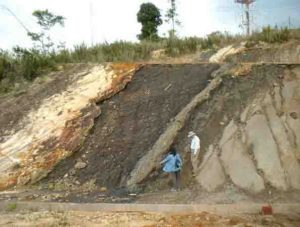
A study on 22–18 million-year-old tidal deposits reveals insights on the significance of mangrove organic carbon sequestration in the South China Sea at geological time scales.
A collaborative study between geoscientists at the Department of Geology, University of Malaya, and the Department of Earth Science and Engineering, Imperial College London, have shown that tidally-generated deposits form significantly thick successions in the Neogene Sarawak Basin. In addition, tidal modelling using reconstructed palaeogeographic maps show that the South China Sea experienced the highest tides on Earth during the Oligo-Miocene, which explains the predominance of tidal deposits in the region. The work also highlights the importance of mangrove organic carbon burial in the South China Sea region as a major component of the global carbon cycle, and the importance of geologic processes (working at the scale of millions of years) in the sequestration of organic carbon.
The study (which is published in a special publication of the Geological Society, London) analysed 72 m of sedimentary rock of the Nyalau Formation exposed around Bintulu, Sarawak, and over 2,000 m of core samples extracted from oil-bearing fields of the Balingian Province, offshore Sarawak (courtesy of PETRONAS). The team has concluded that 22 – 18 million years ago, the Sarawak Basin formed a large, embayed coast, with numerous rivers supplying sediment to the basin. Abundant tidal signatures in the deltaic sediments indicate significant tidal influence.
The results of the sedimentological analysis were also published in Nature Communications, led by Imperial College with collaborations from University of Malaya, University of York and Brunei Darussalam. The researchers looked at the distribution of mangrove coals and mudrocks, which are closely associated with the tidal deposits. Widespread distribution of tidal and mangrove deposits (ranging in age between 15.5 to 11.7 Ma) indicate a predominantly tidally-influenced setting for the South China Sea shelf and associated coastline during the Oligo-Miocene. Oligo-Miocene age, mangrove-derived coals and mudrocks are also widespread throughout the peripheral South China Sea basins, where they form important oil-and-gas source rocks.
Utilizing data on the volume of hydrocarbons (oil and gas) in place, the total volume of sediments that have accumulated in the South China Sea basins and the subsidence history of the basins since the Oligocene, the authors estimate that the organic carbon storage in peripheral South China Sea basins exceeded 4,000 Gt, or equivalent to 2,000 p.p.m of atmospheric CO2.
The researchers are now in the process expanding the work by collecting more data in the northern Borneo region, especially in poorly accessible locations, in order to refine the current palaeogeographic and palaeohydrodynamic models for the Neogene South China Sea.
Reference:
Meor H. Amir Hassan et al. Sedimentology and stratigraphic architecture of a Miocene retrogradational, tide-dominated delta system: Balingian Province, offshore Sarawak, Malaysia, Geological Society, London, Special Publications (2016). DOI: 10.1144/SP444.12
Meor H. Amir Hassan et al. Sedimentology and stratigraphic development of the upper Nyalau Formation (Early Miocene), Sarawak, Malaysia: A mixed wave- and tide-influenced coastal system, Journal of Asian Earth Sciences (2012). DOI: 10.1016/j.jseaes.2012.12.018
Daniel S. Collins et al. Tidal dynamics and mangrove carbon sequestration during the Oligo–Miocene in the South China Sea, Nature Communications (2017). DOI: 10.1038/ncomms15698
Note: The above post is reprinted from materials provided by University of Malaya.










